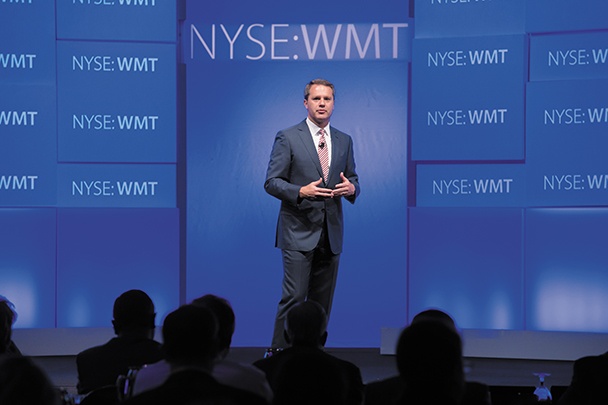CEO Doug McMillon: Company Planning for Long Term
by October 26, 2015 12:00 am 214 views

Revelations from Wal-Mart Stores Inc.’s 22nd annual investors meeting on Oct. 14 in New York City received an immediate response from both the investment community and the media.
During the meeting, Walmart executives presented the company’s current fiscal situation, as well as long- and short-term strategies and expectations.
Chief financial officer Charles Holley said that 2017 would “represent our heaviest investment period” in wages and training and that those investments would have an impact on stock earnings.
“As a result of these investments, we expect earnings per share to decline between 6 and 12 percent in fiscal year 2017,” Holley said, according to a press release. “However, by fiscal year 2019, we would expect earnings per share to increase by approximately 5 to 10 percent compared to the prior year.”
In other words, Walmart’s ongoing investment in its workforce will cause stock shares to drop in value over the next couple of years, but investors could expect to see a turnaround by 2019.
Investor Response
The investment community’s response to Walmart’s announcement was swift. Walmart stock value dropped 10 percent the day of the event, and continued to drop throughout the week. As of Oct. 20, the stock was valued at $58.86 per share.
Mainstream and investment media also wasted no time in explaining lowered stock values. Some sources argued that Walmart’s decision to raise wages was a misstep that hurt revenues and returns for investors.
Others, like Time magazine’s Brad Tuttle, noted that Walmart was due for making some changes in its business model, and that a serious investment in these changes was necessary.
“Above all, the story behind Walmart’s lagging revenue projections and plunging stock price is that Walmart is admitting that it has to do better by employees and customers alike,” Tuttle wrote in an Oct. 15 article.
He also wrote that, for the most part, analysts approve of Walmart’s move in terms of the big picture, in spite of the immediate selloff of stock.
Tuttle cited a CNBC interview with Moody’s analyst Charles O’Shea, where O’Shea said, “We take a longer-term view here. We think this is a good idea going forward as you try to turn the battleship. They have to invest in their employees. They have to invest in price. And they have to invest in e-commerce.”
Walmart’s Response
Walmart CEO Doug McMillon was quick to respond to both the decline in stock prices and Walmart’s critics. He took to the company’s blog the same day as the meeting to point out that while the company is investing a lot of money in technology and its workers, it is also expecting an increase in sales.
“For the first time, we shared a three-year growth plan that includes financial metrics and goals,” he wrote. “We project our sales growth over the next three years will be $45–$60 billion. Think about that. That’s like adding last year’s combined annual revenues of Netflix, eBay, Whole Foods, and Starbucks to our top line.”
McMillon also noted the importance of being able to compete for business both online and in stores, defending the company’s decision to invest in technology, as well as its store associates. Customer satisfaction scores are on the increase, a trend that he attributes to the efforts Walmart is making to provide better wages and training for its associates.
